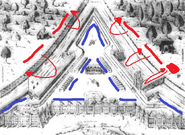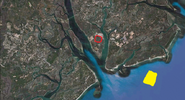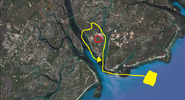POD[]
The Frenchmen, Jean Ribbault, declines to pursue the
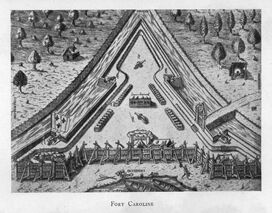
A woodcut of Fort Caroline
Spanish after a comet passes in the sky, showing as a bad omen. He and his men wait out the hurricane that passes through the area in safety.
Bataille de Fort Caroline[]
Don Pedro Menéndez de Avilés, is falsely informed that the Frenchmen were badly hurt during the storm and that most of their men had been killed. Don Pedro Menéndez de Avilés unfortunately believes this and launches an assault on the fort.
The French Huguenot soldiers at Fort Caroline take up defensive positions as their Native American allies inform them that the Spanish are on their way.
The well dug-in troops are able to hold back the Spanish assaults on the fort. The Spaniards that attempt to cross the river are almost all killed with only 70 men from the assault across the river surviving. The Spaniards that attempted to take the gates are pushed back and are able to reform and retreat back to Saint Augustine. During the fighting Don Pedro Menéndez de Avilés was killed by a stray bullet.
Remise de Saint Augustin[]
The French then emerge from their fort and sail down to Saint Augustine. The Spaniards, not wishing for a complete destruction, surrender to the French. Jean Ribbault accepts the Spanish surrender and allows for the Spanish citizens to leave for Cuba. The soldiers that took place in the assault on Fort Caroline are forced to convert from being Catholics to Huguenots, those that refuse are killed. Nearly 60 men were killed in what came to be known as the Matanzas Inlet, although nearly 100 were converted.
The city of Saint Augustine is burned to the ground as the French move back to Fort Caroline with their newly converted Spanish Huguenots.
Premiers Jours[]
The French governor of Floride française, Jean Ribbault, quickly established himself in the region. He was able to attract more and more Huguenots to the colony from France and by the Spring of the following year had been able to attract a ship filled with 600 settlers to Fort Caroline.
The Spanish were forced to give up their colonial ambitions in Florida and King Phillip II officially recognized his loss of Florida by ordering that "sin una mayor colonización de la Florida se llevará a cabo" or in English "no further colonization of la Florida shall take place".
During this time the Wars of Religion were rolling through France and many Huguenots and Catholics were being killed, the only place of refuge it seemed was in the colonies. Many Huguenots continued to flow from France to Fort Caroline, so much so that some soon began to move from Fort Caroline out farther into the wilderness and establish settlements farther from the city.
la Réinstallation de Saint-Augustin[]
The Spanish Huguenots were eager to leave Fort Caroline where they were treated much like second-class citizens and often hated. They petitioned Jean Ribbault to allow them to move back to Saint Augustine, Ribbault agreed and sent 50 soldiers to go with them and their families back to Saint Augustine.
The old burnt remains were of little use to the Spanish Huguenots and they had to clear out the city's ashes before they could rebuild. But they began doing so and by August of 1568 (three months after they left Fort Caroline) they had fully re-established the city to full working order.
Bataille de Parris Island[]
Although the Spanish were defeated in the Floridian Peninsula they were not fully thrown from La Florida. The Spanish still had an outpost on Parris Island, from which they claimed to rule over Florida. The French, though, were not okay with this.
Thus the French organized a venture to attack the Spanish post on Parris Island. A French Naval Fleet of ten ships, filled with 200 French Marines, sailed for Fort Caroline where they picked up 500 more French Huguenot soldiers.
The Catholic French Marines and the Huguenot French soldiers were purposefully separated onto different ships so that there would be no possibility of disorder among the troops.
The French ships first surrounded the island and commenced a full night of bombardment. The French Marines landed on the eastern coast, while the soldiers landed on the western, southern and northern coasts.
The Spanish were quickly overwhelmed and the post was burned to the ground in a matter of three hours after the beginning of hostilities. Only twenty Frenchmen died, although the entire post of Spaniards was put to the sword.
Réclamation Formelle de Colonie d'Floride[]
The French, with this resounding victory in the Americas issued its first official letter of colonization. The colonization order was issued on April 3, 1569.
With this order the French established the Colonie d'Floride or Colony of Florida. It stated that its western boundary was the Mississippi River, its northern boundary was the Saint Louis River, its eastern border the Atlantic Ocean and in the south the Strait of Florida.
The result was a considerable amount of land that was claimed by the French, but a little amount of land that they can actually control.
Quatrième guerre Français de la Religion[]
When the St. Bartholomew's Day Massacre and the Fourth French War of Religion began in France the Huguenot colonists were unaware of the trouble once again brewing in France. Three months after the ruthless attack on Protestants throughout France the news finally reached the capital at Fort Caroline.
An emergency meeting was held by the leaders of the colony to discuss their actions during this new war of religion. They agreed on neutrality after a month of heated debates, and sent the King a letter as such.
King Charles IX was "visually elated by the news that troops would not have to be sent to a far off region to fight only a few people.", as the courier of this message wrote.
At the end of the war the Catholics were wildly successful and were in terms to impose on the "heretical" Huguenots any terms they wished upon them. The result was the Peace of La Rochelle, this treaty banned the French Huguenots from continental France, and the permitting of entirely free religious practices for the Huguenots in the Americas. This, in effect, forced the Huguenots to the Americas and away from France, where they should pose little to no trouble for the monarchy or the Catholic League for a very long time.
La Tragédie[]
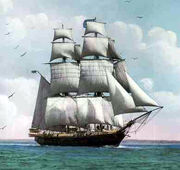
The Éclair, one of the colony ships heading for Fort Caroline
The result was the largest mass migration in the last 300 years of European history. Thousands were lucky enough to escape to Protestant controlled areas in Europe, though many more thousands were not. Protestant cities were quickly taken by Catholic soldiers who forced them to march dozens, if not hundreds of miles to the nearest port. They were loaded on extremely cramped compartments and every sea worthy ship available.
Nearly 10,000 died during this time, including the King's own brother Duke Francis of Anju, who was "accidentally" killed by a French soldier who escaped justice.
The conditions on the ships were terrible, many died from fever, dysentery, scurvy, dehydration, starvation. Some even died as they were suffocated by the mass of people pressing against. Another 1000-6000 were estimated to have died on this journey, but they made it, and those that lived would be forever changed.
News of the banishment (an event called la Tragédie (english: the Tragedy) by the Huguenots) was only given to the "Coloniaux" (Colonials), as the "Européens" (Europeans) called them, when the first ships arrived into Fort Caroline's small ports.
Being quickly overwhelmed by the nearly 170,000 men, women, and children entering the colony the leaders knew they must act quickly to preserve the colony's ability to operate efficiently. After a quick deliberation Jean Ribbault made the crucial decision to re-direct the ships up and down the coast and to have the start their own cities.
This process was slow and many died from native attacks, disease, starvation, and sometimes even "Catholic" pirates who attacked their newly born cities. But after the first two winters these cities were well on their way.



